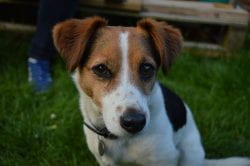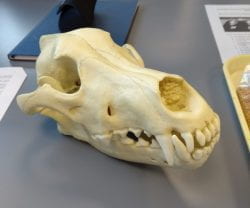By Charlotte Page //
 Dogs are one of the most diverse species on the planet, a feature that is largely due to domestication and human intervention with breeding. Humans have engineered an astonishing variety of dogs with many different traits: brachycephaly, an extreme shortening of the snout, is a prime example of the visible effects of domestication on the canine skull.
Dogs are one of the most diverse species on the planet, a feature that is largely due to domestication and human intervention with breeding. Humans have engineered an astonishing variety of dogs with many different traits: brachycephaly, an extreme shortening of the snout, is a prime example of the visible effects of domestication on the canine skull.
This study aimed to quantify cranial shape changes, and to examine how evolutionary constraints on modularity (the degree to which different regions of the skull covary) affect the changes brought on by domestication. The proposed hypotheses were that decreasing snout length was associated with a decrease in the depth of the orbits, and that modularity would be greater in domesticated dogs than in wild canids: both hypotheses were accepted.
 The findings of this project have applications in evolutionary and veterinary fields. Dogs provide an ideal model for further research into cranial shape change and studies of the effects of artificial selection on modularity. The implications for animal welfare are also highly relevant, as brachycephaly is associated with several health conditions and the increasing popularity of brachycephalic dogs is a growing concern for many.
The findings of this project have applications in evolutionary and veterinary fields. Dogs provide an ideal model for further research into cranial shape change and studies of the effects of artificial selection on modularity. The implications for animal welfare are also highly relevant, as brachycephaly is associated with several health conditions and the increasing popularity of brachycephalic dogs is a growing concern for many.
There were numerous challenges to be overcome during this project: the outbreak of coronavirus meant that the entire study had to be conducted remotely, resulting in all skull data being sourced online. The photographs of skulls available were not all taken from consistent angles, and some photos were too dark or pixelated, resulting in their rejection and thus reducing the sample size. In addition, the distribution of breeds in the sample was not particularly representative of modern dog breeds in the United Kingdom: there were many skulls of large herding breeds for analysis, but few smaller dogs such as terriers, which may have altered the outcome of the study. A continuation of this project should ideally source a greater number of skulls from a wider variety of breed types.
 UROS has been a fantastic experience and has offered me a chance to partake in research into a subject that I find intensely interesting. Working alongside my supervisor, Dr Marcello Ruta, I have developed skills with operating software such as ImageJ and MorphoJ and have gained an insight into the processes involved in the analysis of shape, not just of dog skulls but of other organisms as well. My findings and observations throughout the project have raised further questions for me, such as why brachycephalic dogs appeal to the human brain, and the welfare implications of a significantly altered skull shape.
UROS has been a fantastic experience and has offered me a chance to partake in research into a subject that I find intensely interesting. Working alongside my supervisor, Dr Marcello Ruta, I have developed skills with operating software such as ImageJ and MorphoJ and have gained an insight into the processes involved in the analysis of shape, not just of dog skulls but of other organisms as well. My findings and observations throughout the project have raised further questions for me, such as why brachycephalic dogs appeal to the human brain, and the welfare implications of a significantly altered skull shape.
The knowledge I have gained during this project will help me as I progress into third year and begin my dissertation, and also in the small dog training business that I run alongside my studies, as it has given me a greater anatomical understanding of the variety of breeds I work with each week.
*To view Charlotte’s research poster and presentation recording, please click on the thumbnails below: 

